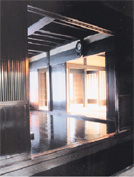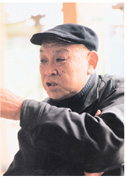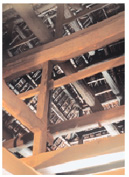Salt of the earth, a story of a noble constructor
We stay in science because we believe in future and feel responsible for the people in the future. However, we often feel being unappreciated because fundamental science does not produce quick money. Similar situation can be found in architecture in Japan. Modern, good-formass- production houses have been shadowing on traditional Japanese houses. Modern houses are cheaper, more comfortable, although it is not necessary true in a long run. In fact, traditional Japanese houses can last a long time and more economical in a long run. But people seem to prefer lower down payment.
  |
It is interesting to note that most traditional Japanese houses do not incorporate diagonal braces. This is intentionally done to keep the building structure resilient and many inventive lumber joints absorb earthquake energy. The traditional construction technology is the result of accumulated experiences through centuries. Nails are not usually used since nails do not last very long. The fact that buildings with such resilient (and not solid) structure have survived through many earthquakes (some over 1000 years) justifies the correctness of such structure in Japan. Unfortunately, there is no computer simulations (which people tend to trust more than facts) to demonstrate the superiority of the traditional structure.
To save traditional houses from total extinction in Tsukuba, the city relocated and restored an old house donated by Yokota family. Now, the house not only serves to show how traditional houses were built, but have been used as a gathering place. It is not a museum to preserve the past, but a place alive to let people experience how nice a traditional construction is. (cover photos)
The leader of the restoration project, Mr. Fumio Tanaka, is one of the most respected carpenters in Japan. He has restored many ancient buildings. These buildings were built hundreds of years ago when no one was required to prove the structural strength for a building permit. Materials and essential structures for modern buildings were well tested and approved, but not so for these of ancient buildings. He has to actually build similar structures and go through a thorough test to get a permission for restoration, although the simple fact that many very old buildings and houses have survived through earthquakes and daily abuse for over centuries should be the living proof. Modern buildings could withstand earthquakes when they are relatively new, but often fail in a long run. But law does not care how it will be in a long run as long as it is safe for a while.
Mr. Tanaka was born in 1932. At his age of 69, he is as active as ever. He teaches and trains his young followers so that they could become familiar with design and technology of traditional Japanese buildings and inherit the disappearing art. He is also supporting a recently started university that teaches traditional technologies of Japan. He is found everywhere; persuading public office people, teaching students, giving talks to general public, directing at construction sites, designing buildings, investigating old building technologies, conducting tests to verify the safety of ancient structures. He was even in Norway in 1989, as he was invited to give a talk at Oslo School of Architecture. It was found that the extinct ancient architectural technology of Norway is still alive in Japan.
He tells his students that there are only 6 possible answers: "I understand",

"I do not understand", "I can", "I can not", "I like it", and "I do not like it". No excuses, no wordiness. Just do it and prove it.
At work, he can be a ticking bomb, at coffee break, he is a loving father. I actually found him a very kind-hearted man. He is also very practical, rational and knows the limitation of the traditional technology very well.
None of his projects were easy and most of them do not have sufficient funds. There aren't so many people who care to preserve old buildings. But, he is willing to do it because he thinks someone has to do it and he is unhappy to see good and beautiful things disappear. Mr. Tanaka is one of the "salt of the earth". Researchers in fundamental science, you are not the only people fighting a lone battle. (TKO)
